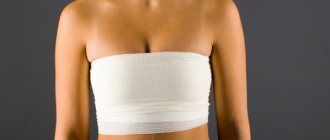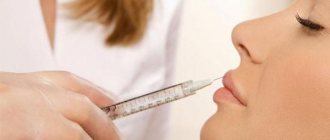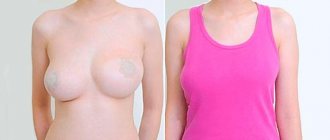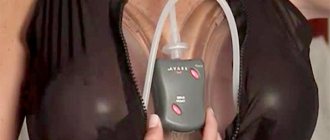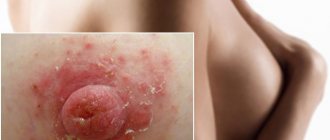Why does seroma appear after mammoplasty?
Seroma is an accumulation of fluid or lymph after plastic surgery to correct the breast.
Fluid accumulation mainly occurs after breast augmentation and when using large implants. This accumulation of the substance causes stretching of the skin and leads to sagging.
The accumulation of serous matter after mammoplasty has a straw-yellow color. Depending on the composition of the cluster, it can change its color and move from yellow to red.
What to do
Despite the large list of contraindications, refusal to undergo plastic surgery to enlarge or change the shape of the breast can be observed in only 3% of cases.
In most patients, surgery can be performed if treatment of the underlying disease is completed or it is in remission for at least six months.
Carriers of hepatitis C or HIV can undergo breast augmentation surgery if the immune system allows it and liver function is restored.
In order to make a decision, the patient needs to see a doctor and undergo an examination. And only after that, after weighing all the factors, should you agree or refuse the operation.
Find out what causes a double bubble after mammoplasty.
What is contracture after mammoplasty? Click to find out.
Causes
The causes of this complication may be:
- The body's reaction to an endoprosthesis. A prosthesis for a woman’s body is a foreign body that can be rejected. The implants are made of biological material, so the likelihood of rejection is very low and passes quickly. But there is always a percentage of women who are sensitive to biological material, which may increase the risk of fluid accumulation after surgery. But modern surgery cannot yet determine the body’s reaction to the implant before surgery;
- Damage to lymphatic vessels. This cause of fluid accumulation in the chest occurs when blood vessels are damaged during surgery. The vessels are restored during the first day after the operation, but sometimes this process slows down, which leads to the release of lymph;
- Bleeding tissue. During surgery, small capillaries tend to leak into the soft tissue of the breast and form a serous substance at the site of implant installation;
- Presence of hematoma . When the resorption of the hematoma begins, accumulations of ichorous substances form and the formation of a seroma. Therefore, it is necessary to monitor the patient for several days after the operation;
- Lack of normal drainage . Any operation, like mammoplasty, is accompanied by the release of lymph, and if it is not removed in time, this provokes complications;
- The body's reaction to suture material . In modern surgery there are a lot of high-quality surgical materials, but none of them are ideal. Also, with a large use of absorbable threads, they lead to accumulation of substances.
Photo: Seroma
Doctors' advice
To avoid the risk of complications, you should strictly follow the instructions of the specialist who performed the operation.
There is general advice from doctors on following basic instructions.
What to do
- After surgery, antibiotics must be taken for 5–7 days to prevent infection. Along with them, non-steroidal drugs, aspirin derivatives and analgesics are prescribed to relieve inflammatory processes.
- When hematomas form, it is recommended to apply ice to the affected areas. In case of hypertension, medications that reduce high blood pressure and increase blood clotting should be prescribed to avoid excessive internal bleeding.
- It is recommended to remove the resulting hematomas of significant size using drainage and hemostatic drugs that are administered orally.
- At first, you need to try to protect yourself from stressful situations and maintain complete peace. This will speed up the process of tissue regeneration.
- The seams are initially treated with alcohol or calendula tincture. Regenerating ointments are used only after 2–3 weeks.
- It is necessary to wear compression garments for several weeks, which promotes proper formation of the capsule and significantly relieves pain. The risk of complications is reduced.
- 2 weeks after mammoplasty, it is recommended to carry out massage procedures aimed at stretching the capsule around the implant.
- For 14–30 days, the patient is allowed to sleep exclusively on her back. Positioning on your side or stomach is strictly prohibited.
Video: Complications after surgery
What not to do
- In the first week after mammoplasty, you must refrain from any physical activity at all.
- The chest must not be overcooled.
- You should give up bad habits such as smoking during rehabilitation.
- During the first 7-10 days, it is unacceptable to remove the medical bra, as well as take baths or showers.
- In the first month after mammoplasty, it is recommended to follow the diet prescribed by your doctor. This will reduce the risk of complications.
- You should not lift heavy objects for up to 1 month. After this period, it is possible to lift not very heavy objects (up to 5-7 kg) without sudden movements.
- For at least the first six months, experts do not recommend making sudden movements with your hands to avoid the formation of a pocket that can be filled with the resulting serous fluid.
- After a month, stress on the lower body is possible. Sports activities involving the use of hands are not recommended for up to six months.
- It is not recommended to sunbathe until six months, as this can lead to pigmentation of the seams.
- A woman is not recommended to become pregnant for six months.
- Visiting a sauna for up to six months is contraindicated, as this can also lead to adverse consequences.
Read what to do if the suture hurts after mammoplasty.
What is vertical mammoplasty? The answer is in the article.
Factors
The accumulation of serous material after mammoplasty appears within 5-7 days after surgery.
Another factor contributing to the appearance of serum may be inflammatory processes in places of skin injury.
There may also be factors such as:
- diabetes;
- excess weight. Greater thickness of subcutaneous fat increases the risk of fluid appearance;
- increased blood pressure;
- age.
Temperature after breast surgery
Typically, a woman may experience an increase in temperature in the early postoperative period. This is due to swelling of the mammary gland, the body’s reaction to foreign bodies, and resorption of the suture material. While in the clinic, pain and hyperthermia are the problems of the attending physician. After discharge from the hospital, an increase in a woman’s body temperature indicates inflammatory processes at the site of surgery and requires attention.
Often, patients themselves provoke the occurrence of various problems in the operated organ by not following the recommendations of their attending physician.
Doctors' advice:
- First of all, you must always wear special underwear. It will be required during the first month after surgery. With its help, a woman achieves the physiological position of the operated mammary gland, which reduces the level of trauma to the operated organ and promotes healing. At the same time, normalization of the temperature regime is noted.
- To relieve pain and stop fever, experts recommend taking non-steroidal drugs, analgesics and aspirin derivatives. After 6-7 days, with careful adherence to the postoperative regimen, there is practically no need for drug support.
Many women notice loss of sensitivity in the breasts during the first two months after surgery. Typically, the skin of the breast becomes more receptive to external irritants, at the same time the areola and nipple become almost cold. This is due to disruption of innervation during surgery and usually recovers by the third month after surgery. Lack of sensitivity rarely coincides with an increase in body temperature and is not a sign of postoperative inflammation.
We recommend reading the article about the rehabilitation period after mammoplasty. From it you will learn what rules you need to follow during the postoperative period to avoid the development of complications, as well as what restrictions you need to observe in your regimen and lifestyle.
Symptoms of seroma after mammoplasty
Do not forget that seroma appears in many women after breast correction, so it is worth consulting a specialist and monitoring the healing process and, of course, paying attention to the symptoms of fluid manifestation for its timely prevention and treatment.
The main symptoms of fluid accumulation may be:
- change in breast shape . The breast increases in volume, a lump may appear in the place where fluid is collected, the contour changes and the nipple moves.
- soft tissue swelling. Since the liquid does not remain outside the capsule, it has the ability to penetrate into soft tissues and when palpated, a certain elasticity and tension of the skin can be felt;
- pain in the area of fluid accumulation . Usually the pain is normal and moderate, but with pressure the pain intensifies. Pain can also be felt during physical activity and walking;
- redness of the skin in the seroma area . This symptom is explained by the fact that the liquid exerts pressure and destroys small vessels, and therefore the color in the area of accumulation may change;
- discharge of serous matter through the edges of the wound. This symptom occurs extremely rarely, but if such a complication persists for a long time, then an outlet may form - a “fistula”, through which the substance will come out. This complication is typical for patients with thin skin.
After breast augmentation, a patient notices that the breasts are enlarged, swelling appears, which increases every day, redness appears in the area where the substance accumulates, and pain becomes more frequent.
Features of bust care
How long do breasts hurt after mammoplasty?
The breasts after plastic surgery will be painful and swollen at first. Hematomas and bruises may form on the mammary glands. This should go away within two to three weeks. Pain and swelling of the mammary glands can bother a woman in the first month with varying intensity. However, if these sensations are very pronounced, you should consult a doctor. During the first two months, the bust is unnaturally raised. After this time, the implants are completely implanted and the breasts drop to their natural position. In the first two years after surgery, there may also be problems with the sensitivity of the breasts, areola and nipples: they may either be too sensitive (especially to burning, irritation, pain) or lose sensitivity completely or partially. Despite the fact that this may be normal and will go away after a while, you should report such symptoms to your doctor.
In order to prevent complications and achieve a speedy recovery of the breasts, a woman should carefully care for the mammary glands until the sutures are completely scarred. Sutures need to be given special attention - to prevent infection from getting into them, to monitor the condition and dynamics of healing.
Seam processing
The sutures after mammoplasty are covered with a bandage to prevent infection and protect from external irritating factors.
During routine visits, the doctor changes the bandage and treats the stitches with an antiseptic. Do not get the bandage wet or remove it yourself. For the first 4 days, showers are taken exclusively in areas below the waist. After two weeks, the bandage is removed and the scars are cleaned if necessary. In the case of using self-absorbing threads, the sutures are not removed - after a certain time they will dissolve on their own. If a dry crust has formed on top of them, it should not be torn off until it falls off on its own.
If the sutures bleed for a long time, become very red, irritated, become visible, or begin to be palpated, you should consult a doctor to rule out infection. In some clinics, after surgery, the patient is prescribed five days of antibiotics to prevent inflammation of the wounds from possible bacteria and infections, and they are also prescribed painkillers.
| Product type | Peculiarity | Example of a drug |
| Antiseptics | At home, the incision sites can be treated with an antiseptic solution, which is recommended by the doctor. | This could be: iodine, pure brilliant green or its solution, potassium permanganate solution, pure alcohol, chlorhexidine, miramistin, hydrogen peroxide. |
| Healing ointments | Four weeks after plastic surgery, the sutures can be treated with moisturizing wound-healing creams. This will speed up their healing. | Vishnevsky ointments, Contractubex and Dermatix, Vulnuzan, Methyluracil, Solcoseryl, Mederma, as well as creams with vitamin E. |
| Plasters | Many doctors advise sticking a special silicone patch over the stitches until they scar. Their use speeds up the healing process and protects wounds from external irritants. | Mepiform, Hudrofilm, Fixopor, Cosmopor. |
The specific type of drug and its brand should be selected by the doctor who performed the operation. It is prohibited to decide on your own to use any drug.
Wearing compression garments
For the first two months after plastic surgery, a woman should wear compression garments.
The first month they use it the whole day, without even taking it off at night. Starting from the second month, wearing it during the day is mandatory, but the bandage can be removed before going to bed. How long you will have to use a compression bra depends on the dynamics of your bust recovery. Some women wear it for 1-2 months, while others cannot take it off for 3-4 months.
The importance of this underwear is very high during the rehabilitation period:
- The compression bodice supports the breasts, fixes the implants in the anatomical pocket, preventing their displacement, rupture of sutures, and stretching of the skin.
- The compression created by such a bra activates blood and lymph flow, reduces inflammation and swelling of the mammary glands, and prevents the appearance of pain.
- Such underwear provides air exchange to the skin, protects the breasts from external irritants and injuries, and prevents stretching of the seams due to physical activity.
- A compression bra limits the mobility of the glands, which promotes their speedy recovery and reduces the load on the back and shoulder area.
- Thanks to it, the breasts are in an ideal position, are not compressed, and do not move in different directions.
Nowadays you can find many options for compression garments. A good choice would be a bra with the ability to adjust the compression level to select the required values according to the recovery rate.
Refusal to wear compression garments can negate all the results of plastic surgery and lead to the following consequences:
- Implant displacement.
- Stretching, tearing of seams.
- Breast drooping.
- Bust asymmetry.
- Skin stretching.
- Injury to the mammary glands during physical activity.
- The need for a breast lift.
- The need for repeated surgery due to displacement, rupture, reconstruction (deformation) of implants.
After the doctor gives permission to remove the compression top, you need to take care of purchasing comfortable, soft and non-tightening underwear. In addition, the new bodice should support the breasts and not squeeze them, have wide straps and a deep cup. You can switch to classic underwear 1 year after surgery.
Personal hygiene and skin care
For the first three days, it is forbidden to bathe in the shower or bathtub at all.
Starting from the fourth day after mammoplasty, you can shower in the area below the waist. After removing the bandage from the stitches, you are allowed to bathe completely in the shower, but it is permissible to take a bath only a month after the operation. When swimming, the water should not be cold or hot, only warm (37-37.5 degrees). The shower stream should be diffused, not directed.
Under no circumstances should you rub your chest with a towel. It is better to gently blot it with a non-hard towel until it dries.
Frequent use of soaps or gels to wash your breasts is not recommended. It is better to do this no more than twice a week, and the rest of the time just wash it with water. Frequent use of soap will cause dry skin, which will slow down healing.
Four weeks after the operation, you can start using regular moisturizing creams for skin care, based on vitamins E and A, oils, and herbal extracts. It would be good if they additionally have wound-healing properties. These may be means:
- Mama Comfort.
- Johnson's baby.
- "Baby Pharmacy" from VITEX.
- Mothercare it's your body.
- Cream "Children" from any company.
- Avent cream.
You can add natural oils and mumiyo powder to the cream. The application of alginate masks and seaweed wraps (not heating) are allowed.
Massotherapy
Massage of the operated breast after mammoplasty can reduce the risk of complications after surgery. The first time a doctor shows a woman the technique of therapeutic massage, then she must do it at home on her own, at least every other day.
The best time for a massage procedure is morning. The duration of the massage is determined by the doctor in accordance with the tendency to recovery.
Massage should begin no earlier than the fourth day after the operation. For the first two to three weeks, light circular stroking of the mammary glands will be sufficient. When massaging the left breast, it is supported with the left hand from below. The index, middle and ring fingers of the right hand are folded together, placed with pads on the circumference of the glands and carried out in soft circular movements, starting from the axillary region, in a clockwise direction to the collarbone. The same procedure is performed with the right breast, only the supporting and massaging hand changes.
From the fifth to sixth week you can start doing lymphatic drainage massage. It activates blood and lymph flow, promotes the healing of sutures. Massage technique:
- The middle, ring and index fingers of the hand are folded, then they make circular movements around the circumference of the glands.
- The movements begin from the armpit, continue in a circular direction and end at the collarbone.
- Move your palms along the bust - down, then left and right.
- Place your palms on the glands and gently guide them towards each other using circular movements.
- Place your palms on top of your chest and make gentle pressing movements.
- Stroke the bust along the contour clockwise.
- Finally, lightly rub the glands with your palms.
It is better to do the massage while sitting or lying in front of a mirror to control your movements. The duration of the procedure is on average about 10 minutes. Before the procedure, you need to soak your hands in linseed, lavender or coconut oil.
Massage is required in the following cases:
- Persistent sensation of implants for a long time.
- Palpable pain in the chest.
- The appearance of painful lumps.
- Numbness of scar tissue.
Massage is contraindicated in purulent, inflammatory processes that occur as a result of unsuccessful mammoplasty.
Physical activity and sports
Recovery after mammoplasty involves abstaining from excessive physical activity and active sports training:
- In the first three days, peace is indicated.
- In the next two weeks, walking and short walks are recommended.
- Starting from the second week, you can begin light homework.
- After the stitches have healed and the bandage has been removed, doctors recommend starting to do therapeutic exercises to restore and strengthen the pectoral and shoulder muscles.
You need to start physical activity gradually. A month after the operation, you can perform simple exercises: raising your arms, swimming short distances, raising your arms with small weights (up to 1-2 kg).
Two months after consulting with a doctor, you can slowly begin jogging, fitness, and aerobics. After three months, you are allowed to do stretching and abdominal exercises. Push-ups, chest presses, and stretching of the pectoral muscles are allowed only 25 weeks after surgery.
The duration of the period of abstinence from physical activity and the type of permissible load largely depend on the density and size of the implants and the method of their engraftment. When installing denser, larger prostheses, using the endoscopic method of breast augmentation and the axillary approach technique, the rehabilitation period will be longer. Accordingly, it will be possible to start exercising a little later (by a week or a week and a half).
Diagnostic methods
Diagnosis methods for complications include:
- ultrasonography;
- x-ray mammography;
- Magnetic resonance imaging.
Using ultrasound, you can determine the internal changes occurring in the breast area after mammoplasty, determine the degree of seroma development and diagnose it in the early stages of formation.
X-ray mammography is indicated for all women who have ever undergone breast surgery, as well as women over 40 years of age.
This research method helps to assess the nature of the condition of the mammary glands and helps determine the nature of the formation of nodes, compactions and the formation of fluids in the breast area.
Unlike X-rays, magnetic resonance imaging involves the absence of radiation exposure and diagnosis is carried out for each case separately.
Magnetic resonance imaging will help monitor the condition of implants after mammoplasty, and also help prevent the development of complications such as seroma and contracture.
What happens to the body after surgery
The body’s reaction to mammoplasty is manifested by the following obvious symptoms:
- swelling;
- feeling of tightness in the chest area;
- pain;
- hematomas;
- increase in body temperature.
In the first weeks or even months, the breasts may not correspond to the expected shape due to swelling of the mammary gland. Hematomas appear, which go away a few weeks after the operation.
The woman begins to experience discomfort and pain, which is most disturbing in the early morning: from 3 to 6 o’clock. The level of pain largely depends on the location of the implants.
An elevated temperature of 37.5–38 degrees is often observed, which lasts an average of 7–10 days. After this, the inflammatory process gradually subsides. Swelling subsides, hematomas go away, and the temperature returns to normal.
Treatment options
Such a formation in the breast as a gray tumor can be treated using two methods, such as surgery and medication. Large lesions can be treated simultaneously in two ways.
The surgical method is accompanied by the presence of adequate drainage.
A drain is installed to remove serous fluid and can be left in place for two to three days. Based on the amount of substance released, a specialist can judge whether the drainage should be removed or not.
Drainage is a fairly popular method of treatment, in which the process of removing the discharged substance from places of accumulation occurs.
Special devices can be removed from the wound, but generally, specialists remove fluid through special punctures located around the wounds.
Dangers
A very big mistake is the statement that seroma will resolve itself without additional treatment and prevention.
In most cases, this may be true, but there is always a risk of an increase in the volume of fluid, which on its own cannot disappear and resolve.
This leads to subsequent complications such as:
- Formation of a serous fistula . In this case, the serous substance independently seeps through the soft tissue. Most often these are the edges of the wound. Such leakage can last up to several weeks, which contributes to infection of the endoprosthesis, which entails a repeat operation;
- Development of capsular contracture. The accumulation of fluid accompanies inflammatory processes, which ultimately leads to an increase in excess tissue. In turn, such tissue promotes the development and formation of the capsule;
- Suppuration of the place where the implant is located. The serous substance is an ideal place for the accumulation and development of bacteria, which can lead to suppuration of the implantation pocket.
When does seroma appear?
Lifetime warranty on implants
There is no specific time interval between surgical intervention and the formation of seroma. It is difficult to name the factors that stimulate fluid accumulation. However, the general likelihood of developing this anomaly is as follows: the greater the extent of surgery, the greater the likelihood of developing seroma. Seroma can appear in any part of the body that has been injured or undergone surgery.
It is diagnosed during a mammological examination, but, as a rule, the accumulation is clearly visible to the naked eye and is easily palpable.
Prevention
The best solution to the problem of fluid accumulation is timely consultation with a doctor and prevention.
Conventionally, the prevention of fluid prevention can be divided into levels:
- Preoperative;
- Interoperational;
- Postoperative.
Preoperative prevention is:
- taking tests;
- consultation and selection of a plastic surgeon;
- Ultrasound of the mammary glands;
- electrocardiogram;
- consultation with a gynecologist.
Interoperative prevention is directly related to the actions of the plastic surgeon and methods of performing plastic surgery, which include:
- correct choice of area for implant placement;
- adequate incision placement;
- timely wound drainage;
- high-quality sutures.
Postoperative prevention is directly related to the patient’s behavior during the rehabilitation period.
In the postoperative period, the patient must follow the following rules:
- wearing compression garments;
- attending all consultations and following all recommendations of the attending physician;
- restriction of physical activity and movement.
Photo: Compression underwear
Compliance with all preventive measures and careful attitude towards your health will give you a good aesthetic result after surgery and reduce the risk of complications after mammoplasty.
Prevention of the appearance of serous matter also includes the following actions:
- suturing the wound without leaving pockets;
- apply a pressure bandage to the wound area for several hours;
- constant use of antiseptics and antibiotics at all stages of treatment.
See what ripping looks like after mammoplasty.
Study the list of restrictions after mammoplasty in this article.
What is the cost of mammoplasty? Read more.
The most common questions from women
If a woman wants her breasts to look full, beautiful and round after surgery, she must follow all the rules of the post-operative period.
Recommendations after mammoplasty are given by the doctor. Below are answers to the most common questions from women who have undergone breast enlargement surgery.
When can you sleep on your side and stomach?
For the first two weeks after surgery, you are allowed to sleep only on your back. Starting from the second week, a woman can sleep on her side. Sleeping on the stomach is allowed no earlier than a month after mammoplasty.
Such requirements are justified by the fact that when lying on the side and stomach, the pectoral muscles tense, the chest is pressed in - this can lead to displacement of the implants, severe pain, and divergence of the seams on the incisions.
When can sexual activity be resumed?
Since having sex can be compared to physical activity by increasing heart rate and blood pressure, you should not begin sexual activity immediately after surgery. In addition, the process may cause displacement of the implant or damage to the sutures.
As a rule, a medical ban lasts from 2 weeks to 1 month.
Is it possible to visit the bathhouse?
Throughout the entire rehabilitation period, which is at least two months, visiting the bathhouse is strictly prohibited. You can go to such an institution only after the stitches have completely healed. Doctors' advice is to refrain from bathing for at least 5-6 months after surgery.
The increase in temperature that occurs in the bath activates the production of sweat and lymph flow. Insufficient moisture enters the internal organs and is wasted on lowering the body temperature and saving it from overheating. Also, increased stress is placed on the cardiovascular system. These processes prevent the healing of sutures and restoration of the bust after plastic surgery. Violation of this rule may lead to the development of postoperative complications.
Pouring cold water after a bath will also have a negative impact on women's health. Additional stress on the body can lead to illness, because the patient’s immunity is already weakened.
When can you wash?
You can shower on the fourth day after plastic surgery, but swimming is only allowed in the area below the waist. After the stitches are removed (approximately the second week after surgery), you are allowed to take a full shower.
Bathing in the bathroom is prohibited for the entire first month after surgery. Under no circumstances should the water when bathing be cold or hot. You can only wash with warm water 37-37.5 degrees.
Visiting the pool is allowed 4-5 months after surgery.
Is it possible to drink alcohol?
Doctors strongly recommend staying away from alcohol for the first two months after plastic surgery. This is due to the following factors:
- In the first time after surgery, a woman may be prescribed painkillers and antibiotics, and their use is not compatible with alcohol. Otherwise, adverse reactions may develop.
- Alcoholic drinks slow down the healing process and wound healing.
- Since the body is weakened after surgery, alcohol can lead to the development of diseases and exacerbation of chronic diseases.
You can start drinking alcoholic beverages no earlier than two months after surgery, but in any case not before the sutures have completely healed. A similar ban applies to smoking.
When does the first menstruation occur after surgery?
On average, menstruation after mammoplasty can be delayed by 1-2 months, since the body has suffered serious stress, needs a long recovery, and was also under the influence of anesthesia. Due to endocrine changes occurring in the body, a temporary disruption of the menstrual cycle is possible.
Normally, the process should stabilize and be accompanied by the usual symptoms: breast swelling, aching pain, irritability, mood swings, etc. If, despite the positive dynamics of suture healing and the absence of complications, menstruation does not begin after 2 months of rehabilitation, you need to visit a gynecologist. The doctor may prescribe a course of hormonal medications.
Why seroma occurs after mammoplasty and how to deal with it
The recovery period after breast correction for aesthetic or medical reasons does not always go perfectly smoothly. We will talk in more detail about one of the problems that patients often face.
Seroma is an accumulation of tissue fluid (lymph) under the skin that occurs due to damage to the walls of blood vessels during mammoplasty and other surgical operations. Depending on the size and overall clinical picture, this complication can be practically harmless, or it can pose a serious threat to health. Why does it appear and how to recognize it at the earliest stage? What should be the treatment and what should be done to avoid repeat surgery? TecRussia.ru examines with utmost care:
↑ Causes and mechanism of occurrence
The risk of seroma is present with any surgery on the mammary glands:
- plastic – breast augmentation, reduction and lifting;
- oncological – mastectomy and lumpectomy (complete or sectoral resection)
However, the complication rate varies significantly: for aesthetic corrections it is only 1-2%, for much more traumatic operations as part of cancer treatment it reaches 35%. The exact reasons for the development of pathology are still unknown to doctors. As a rule, this occurs when several different risk factors are combined:
- Injury to the lymph nodes occurs due to careless movements with a scalpel during surgery.
- Increased bleeding - when the arteries are damaged, blood penetrates into the soft tissues, where it is subsequently converted into serous fluid.
- Formation of a hematoma - during its resorption, ichor accumulates, from which a seroma is then formed.
- Excessive compression of tissue when installing excessively large breast implants.
- Poor drainage performance contributes to a deterioration in the outflow of lymph, which gradually accumulates at the site of intervention.
- Diabetes, obesity (and overweight in general), hypertension and other chronic diseases.
- Smoking negatively affects tissue healing processes and significantly increases the likelihood of any postoperative complications.
- Failure by the patient to comply with the doctor’s recommendations - early start of physical activity, lack of care for sutures, refusal to wear compression garments or incorrectly selected size.
Anatomically, the following happens in the body:
- In response to inevitable surgical damage to blood and lymphatic vessels, as well as surrounding tissues, an inflammatory response develops. It is accompanied by the release of fluid - this is what causes pain and swelling in the injured areas.
- If too much fluid comes out, or its unimpeded outflow is not organized, it begins to accumulate in the subcutaneous cavities - this is a seroma. The color and consistency of the serous substance may vary depending on its exact composition. The reddish tint is given by red blood cells, the pale yellow color is given by leukocytes, macrophages and other blood cells. The increased viscosity is due to the presence of proteins and lipids.
↑ Signs and symptoms
Seroma is divided into early - occurs within the first year after surgery - and late - more than 1 year: there are cases where the pathology developed 10 and even 15 years after surgery (Western doctors often associate this with the installation of textured breast implants).
In the most typical version, the first alarming symptoms appear 1-2 weeks into the recovery period. A woman notices a significant change in the shape of the mammary gland and its volume, accompanied by hyperemia and soreness.
Stagnation of serous fluid can occur on one side or on both sides; in the first case, pronounced asymmetry develops.
Features of breast examination after mammoplasty
- Most experts believe that silicone implants are not harmful to health. But implants reduce full breast visualization during mammography.
- The implant may affect the rest of the breast tissue architecture, displacing and compressing it so that the signs of early breast cancer—microhardness, tissue distortion, and small dense masses—are not visualized.
- Implants limit the compression force required for optimal breast visualization during mammography. Because of the additional images required, more radiation will be required during a mammogram.
- Calcifications due to scarring around the implant can mimic cancer.
Seroma after mammoplasty: causes and methods of elimination
Seroma after mammoplasty is considered a rare specific surgical complication. No more than 1% of people encounter the problem of seroma after mammoplasty. Responsibility for its occurrence falls on the surgeon if all aspects are not followed during the operation and on the patient if recommendations are not followed in the postoperative period.
The first signs of seroma after mammoplasty appear 4–14 days after breast augmentation procedures. The woman pays attention to the asymmetry: one gland enlarges and swells, which is accompanied by pain and redness of the skin. Do not confuse gray after mammoplasty with normal swelling, which goes away on its own.
Complications and mammoplasty: seroma
Seroma is a liquid, the consistency and color of which depends on its composition. Slightly yellow, slightly viscous, it contains lymphocytes, leukocytes, macrophages and other blood cells. The red tint of the seroma is given by red blood cells, and the viscosity is given by lipids and proteins.
Seroma after mammoplasty. What to do?!
Seroma is a rare complication after mammoplasty, occurring in only 1-2 percent of patients. Most often occurs after breast augmentation with large-volume implants and after a mastectomy. There are also risks for patients with diseases such as diabetes, obesity and high blood pressure. Older patients are also at risk. The culprits for the occurrence of this disease can be either a patient who does not correctly follow all the recommendations during the rehabilitation period, or a surgeon who made a mistake during the operation. This is a very unpleasant and dangerous complication. Seroma is a viscous liquid with a sweetish odor and a yellowish tint, which contains lymphocytes, leukocytes and other blood cells.
Seroma, what is it and how to treat it
The presence of seroma after breast surgery is most often observed when large implants are used and breast augmentation. Fluid accumulates under the skin and can cause it to stretch. Subsequently, the breasts become less firm and sag. Seroma after mammoplasty is considered a complication not so much dangerous as unpleasant. As a rule, it occurs in the early stages after surgery - 5-10 days after breast surgery.
Signs of seroma after mammoplasty:
- breast asymmetry, namely changes in the breast in the area of fluid accumulation;
- slight pain;
- redness of the skin;
- asymmetrical swelling;
- leaking serous fluid through wounds;
In cases of suspected accumulation of serous fluid, you must consult a doctor who will prescribe the necessary tests and treatment. Diagnosis of seroma after mammoplasty is performed by examination, ultrasound, MRI or mammography. The surgeon operating on you will advise which diagnostic method to choose.
Causes of seroma after mammoplasty:
- internal bleeding;
- failure to drain the operated area or poorly performed procedure;
- large hematomas can lead to fluid accumulation; observation is necessary if they are present;
- reaction to suture material;
- excessive tissue burn by coagulator;
- infection;
- injury to lymphatic vessels;
- early physical activity on the part of the patient;
- failure to follow all doctor’s recommendations after mammoplasty.
How the rehabilitation process works day by day
Rehabilitation after breast surgery takes about two months. It will take at least six weeks for the implants to take root in the mammary glands. The entire rehabilitation period can be divided into two stages:
- Postoperative – characterized by a large number of strict restrictions and obligations, the implementation of which is aimed at avoiding postoperative complications. Lasts a month.
- The recovery stage is a less strict stage, during which all efforts are aimed at restoring the bust, pectoral, and shoulder muscles after surgery. A little physical activity is already allowed here, and therapeutic exercises are encouraged.
Rehabilitation by day after breast augmentation is as follows:
| Day | Rehabilitation actions |
| First | After the operation, the patient is under the supervision of a doctor and junior medical staff so that in the event of complications or consequences of anesthesia, medical assistance can be provided immediately. The first day is quite painful for the woman, as she recovers from anesthesia. In most cases, doctors prescribe painkillers, sometimes antipyretics, as well as an antibiotic to prevent inflammatory and purulent processes. Immediately after the operation you cannot lie down, you can sit or take a semi-lying position. By the evening, if the dynamics are positive, you will be able to get up and walk around a little. You can drink no earlier than three hours after the procedure, and eat a little after five hours. If you are very thirsty, wipe your lips with a cotton pad moistened with water. |
| Second | The doctor examines the patient. If all is well, the drainage is removed and a dressing is done. In some clinics, under favorable circumstances, a woman is allowed to go home on the second day, in some – on the third. |
| Third fourth | This period is characterized by a home regime. A woman should not overexert herself physically, but moderate walking is beneficial for her. |
| Fifth | The patient must come to the clinic for examination and dressing. |
| Sixth – eleventh | The woman is slowly returning to her pre-operative lifestyle. You should still avoid excessive exercise, sports, and even light lifting. |
| Twelfth day | A penultimate visit to the clinic for examination is scheduled. |
The next and final visit to the hospital will be in the sixth week after surgery.
One and a half to two weeks after plastic surgery, you can begin light housework. Sports training can be started only after a month, after consulting with a doctor.
Treatment of seroma after mammoplasty
In most cases, seroma resolves on its own within a few days, less often it accumulates, causing physical discomfort to the patient and leading to more serious complications. That is why regular examinations after mammoplasty are very important; this will promptly prevent the risk of complications, and in cases of complications, quickly eliminate them.
Treatment of seroma after mammoplasty includes:
- medicinal method - treatment with antibiotics and anti-inflammatory drugs, helps in cases of small amounts of accumulation of serous fluid;
- surgical method - installation of drainage through small punctures, as a rule, drainage is installed for several days to drain excess fluid and blood;
- combination of drug and surgical treatment;
- vacuum aspiration – a special device uses a vacuum to pump out fluids from tissues through newly dissected postoperative scars.
Lack of treatment can lead to serious problems - suppuration, necrosis and capsular contracture. In this case, treatment will consist of removing the implants. Remember, timely examinations, strict adherence to the rehabilitation period, and most importantly, a competent choice of surgeon - guarantee a successful outcome of the operation and minimize the risk of seroma after mammoplasty.
© PlasticRussia, 2020. All rights reserved. Full or partial copying of site materials without the consent of the portal administration is prohibited.
What not to do after breast augmentation and how to avoid complications
To prevent the development of complications, a woman must clearly and strictly follow the recommendations and not overstep the doctor’s restrictions.
In the first three hours after surgery, the patient should not drink, during the first five hours, she should not eat, and for the first four days, she should not shower.
It is prohibited during the first week after mammoplasty:
- Lie down and sleep on your stomach.
- Raise your arms to a level above your shoulders.
- Lift heavy objects (more than 1 kg).
- Make sudden movements.
- Tilt your torso down.
It is not recommended to drive a car or enter into intimate relationships for two weeks. In the first year, you must use contraceptives to prevent pregnancy.
You can start physical training no earlier than a month after the procedure. Throughout the entire rehabilitation period, stress, depression, any nervous tension, anxiety, or significant changes in body weight are contraindicated.
Particular attention should be paid to diet. Drinking alcohol and smoking are prohibited. You should limit sweet, salty, spicy, fried, and fatty foods. It is not recommended to drink a lot of liquid.
During the year it is forbidden to go to the solarium, bathhouse, sauna, to be in direct sunlight, or to take a hot bath.
